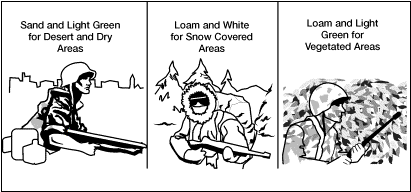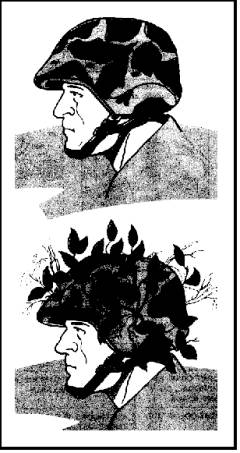|
Conditions: Given load-carrying equipment (LCE), an individual
weapon, a Kevlar helmet with camouflage
cover, grass, bushes, trees, shadows, pieces
of the lightweight camouflage screen system
(LCSS), skin paint, and charcoal and/or mud
for camouflage.
You are wearing a battle dress
uniform (BDU).
SPECIAL CONDITIONS: When this task is performed in a nuclear,
biological and chemical (NBC) environment,
there will be no change in standards due to
mission-oriented protective posture (MOPP)
4.
Standards:
Camouflage yourself and your individual
equipment to prevent detection by visual,
near-infrared, infrared, ultraviolet, radar,
acoustic, and radio sensors.
|
Performance Steps
|
|
1. Identify critical camouflage considerations,
incorporating an analysis of the
following considerations:
|
a.
Movement.
|
|
Note. Movement draws attention, and darkness does not prevent
observation.
The naked eye and
infrared/radar sensors can detect
movement.
|
(1)
Minimize movement.
|
(2)
Move slowly and smoothly
when movement is necessary.
|
b.
Shape.
|
(1)
Use artificial materials to
break up shapes, outlines, and
equipment.
|
(2)
Stay in shadows when
moving.
|
(3)
Disguise or distort the
shape of your helmet and your body
with artificial materials when
conducting operations close to the
enemy.
|
c.
Light reflection. Cover or
remove the following items eliminating
light reflection:
|
(1)
Mess kits.
|
(2)
Mirrors.
|
(3)
Eye glasses.
|
(4)
Watch crystals.
|
(5)
Plastic map cases.
|
(6)
Starched uniforms.
|
(7)
Clear plastic garbage bags.
|
(8)
Dust goggles worn on top of
helmets.
|
(9)
Cigarettes and pipes.
|
(10) Red-filtered
flashlights.
|
|
Note. Replace all red filters on flashlights with blue-green
filters.
|
d.
Color. Blend individual
camouflage with the surroundings, or
at a minimum, ensure that objects do
not contrast with the background
(figure 052-191-1361-1).
|
|
Note. When moving from one area to another, change camouflage
as required.
What works well in one location
may draw fire in another.
|
|
2. Camouflage your skin.
|
|

Figure
052-191-1361-1. Colors
used in camouflage
|
|
Note. Exposed skin reflects light.
|
a.
Cover your skin oils, even
if you have very dark skin, using
paint sticks.
|
|
Note. Paint
sticks cover these oils and provide
blending with the background.
Note. Do not use
oils or insect repellant to soften
paint sticks.
This defeats the purpose of
paint sticks by making the skin shiny.
Work in pairs when applying
paint, because self-application may
leave gaps, such as behind the ears.
|
b.
Use information in table 052-191-1361-1
when applying paint on the face.
|
|
Table
052-191-1361-1. Color
Chart
|
|
|
Skin
Color
|
Shine
Areas
|
Shadow
Areas
|
|
Camouflage
material
|
Light or dark
|
Forehead,
cheekbones, ears, nose, and chin
|
Around eyes,
under nose, and under chin
|
|
Loam and light
green stick
|
All troops use
in areas with green vegetation
|
Use loam
|
Use light green
|
|
Sand and light
green stick
|
All troops use
in areas lacking green vegetation
|
Use light green
|
Use sand
|
|
Loam and white
|
All troops use
only in snow-covered terrain
|
Use loam
|
Use white
|
|
Burnt cork, bark
charcoal, or lamp black
|
All troops, if
camouflage sticks not available
|
Use
|
Do not use
|
|
Light-color mud
|
All troops, if
camouflage sticks not available
|
Do not use
|
Use
|
c.
Paint high, shiny areas
(forehead, cheekbones, nose, ears,
chin) with a dark color.
|
d.
Paint low, shadow areas
with a light color.
|
e.
Paint exposed skin on the
back of the neck, arms, and hands with
an irregular pattern.
|
|
CAUTION:
Mud contains
bacteria, some of which is harmful
and may cause disease or infection.
Mud should be considered as a
last resort as field expedient
paint.
|
|
CAUTION:
Expedient paint
containing motor oil should be used
with extreme caution.
|
|
3. Camouflage your BDU and helmet.
|
a.
Roll your sleeves down and
button all buttons.
|
b.
Attach leaves, grass, small
branches, or pieces of LCSS to your
uniform and helmet (figure 052-191-1361-2).
|
|

Figure
052-191-1361-2.
Camouflaged helmet
|
|
Note. These items will distort shapes and blend colors with
the natural background.
Note. BDUs provide visual and near-infrared camouflage.
|
c.
Do not starch BDUs.
|
|
Note. Starch counters the infrared properties of the dyes.
|
d.
Replace excessively faded
and worn BDUs because camouflage
effectiveness is lost.
|
|
4. Camouflage your personal equipment.
|
a.
Cover or remove shiny
items.
|
b.
Secure items that rattle or
make noise when moved or worn.
|
Evaluation Preparation:
Setup: Ensure that all
materials required in the conditions are
available to the soldier.
The buddy system should be used when
applying paint to the face.
Brief
Soldier:
Tell the soldier, in preparation for
unit defense, he is to identify critical
camouflage considerations, camouflage
himself or a buddy’s exposed skin with paint
sticks, and camouflage his individual
equipment.
|
Performance
Measures
|
GO
|
NO GO
|
|
1. Identified critical camouflage considerations.
|
—
|
—
|
a.
Minimized movement, and
moved slowly and smoothly.
|
|
|
b.
Broke up, disguised, or
distorted shapes and outlines.
|
|
|
c.
Covered or removed
light-reflecting items.
|
|
|
d.
Blended camouflage with the
natural surroundings.
|
|
|
|
2. Camouflaged exposed skin.
|
—
|
—
|
a.
Selected the correct
combination of paint sticks for the
present location.
|
|
|
b.
Used paint sticks to
camouflage exposed skin on face with
irregular patterns.
|
|
|
c.
Used paint sticks to
camouflage exposed areas of neck,
arms, and hands with irregular
patterns.
|
|
|
|
3. Camouflaged uniform and helmet.
|
—
|
—
|
a.
Ensured that uniform was
not faded or starched.
|
|
|
b.
Rolled down and buttoned
both sleeves.
|
|
|
c.
Broke up shape and pattern
by attaching leaves, grass, small
branches, and/or pieces of LCSS to
uniform and helmet.
|
|
|
|
4. Camouflaged personal equipment.
|
—
|
—
|
a.
Covered or removed all
items that reflected light (for
example, mess kits, mirrors, eye
glasses, watch crystals, plastic map
cases, starched uniforms, plastic map
cases, clear plastic garbage bags,
goggles worn on top of helmet, and
red-filtered flashlights).
|
|
|
b.
Secured items that rattled
or made noise when moved or worn.
|
|
|
Evaluation
Guidance:
Score the soldier GO if all
performance measures are passed.
Score the soldier NO GO if any
performance measure is failed.
If the soldier fails any performance
measure, show him how to do it correctly.
|
References
|
|
|
Required
|
Related
|
|
|
|
FM
20-3
|
|
|
|
FM
21-75
|
|